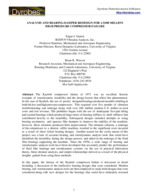Papers
“Analysis and Bearing-Damper Redesign for a $100 Million High Pressure Compressor Failure,” |
Abstract
The Kaybob compressor failure of 1971 was an excellent historic example of rotordynamic instability and the design factors that affect this phenomenon. In the case of Kaybob, the use of poorly designed bearings produced unstable whirling in both the low and high pressure compressors. This required over five months of vibration troubleshooting and redesign along with over 100 million modern U.S. dollars in total costs and lost revenue. The problems began with the use of inadequate five-pad tilting pad journal bearings which produced large ratios of bearing stiffness to shaft stiffness that contributed heavily to the instability. Subsequent designs included attempts at using bearing asymmetry and squeeze film dampers to improve the stability of the machine, however these solutions produced little improvement. The ultimate solution, a redesign of the compressor to a shorter, stiffer machine, resulted in the significant costs incurred as a result of these failed bearing designs. Another reason for the costly nature of this project was a lack of accurate bearing and rotordynamic analysis tools that could have identified the instability during the design process and aided in the redesign of the fluid film bearings supporting the machine. Since the 1970s, a wide range of bearing and rotordynamic analysis tools have been developed that accurately predict the performance of fluid film bearings and rotordynamic systems via the use of practical lubrication theory, finite element analysis, and simple relationships derived as a result of the physical insights gained from using these methods.
In this paper, the history of the Kaybob compressor failure is discussed in detail including a discussion of the ineffective bearing designs that were considered. Modern bearing and rotordynamic analysis tools are then employed to study both designs that were considered along with new designs for the bearings that could have ultimately restored stability to the machine. These designs include four-pad, load-between-pad bearings and squeeze film dampers with a central groove. Simple relationships based on the physics of the system are also used to show how the bearings could be tuned to produce optimum bearing stiffness and damping of the rotor vibration, producing insights which can inform the designer as they perform more comprehensive analyses of these systems.

